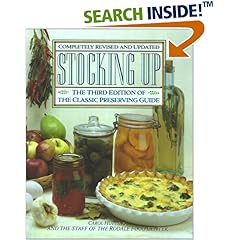But back to canning tomato sauce recipes. (Can I state it like that? Oh well, y'all know what this is about anyway.) For canning I pretty much rely on the book "Stocking up" by Carol Hupping and Staff. I bought my book used for around $8.50 including shipping here.**

Her tomato sauce recipe*** is for canning or freezing as follows:
5 lbs Italian plum tomatoes (about 25)
1 TBSP Olive Oil
1 Onion, chopped
1 Clove garlic, crushed
1 TBSP chopped green peppers
2 TBSP finely chopped carrots
2 TBSP finely chopped celery
2 TBSP finely chopped parsley
1 tsp oregano
1 bay leaf
pepper to taste
1/4 cup lemon juice (if canning)
You can use the tomatoes with or without their skins. I chose with because it was less prep work and you get to keep more of the "good stuff" (i.e. vitamins, minerals, nutrients) apparently found just below the skin according to Carol. Just wash, cut them up, scoop out the innerds/seeds and puree the heck out of them! This the most important step! It will determine how smooth your sauce is! The skins do create a texture to the sauce, and no amount of slicing, dicing, or blending will get them PERFECTLY smooth. If smoothness is your game, you may want to parboil the tomatoes and remove their skins first. Set aside.
Then grab a large pot (enamel or stainless steel) and saute the onions and garlic in the oil. According to the directions, next stir in the green peppers, carrots, celery and tomatoes. I know my hubby and myself and I know that if I put in carrots or celery or peppers we would freak out a little, so I just skipped that part. (Side note: This will of course reduce the volume of your sauce.) Then add the parsley, oregano, bay leaf and pepper. I recommend fresh herbs for this, as you are stewing the tomatoes in a later step and the dry herbs are a little too potent. TRUST ME! I didn't add the bay leaf, because I normally DON'T put it in my spaghetti. (If you do include the bay leaf, be sure to take it out before canning.) Also I added salt, because I normally DO put it in. The exact amount of salt I couldn't tell you, because it's measured in the palm of my hand. (Sorry that's the best measurement I got for ya!) Salt in high enough quantities is a preservative, and I added so little that I wasn't worried about it affecting the pH, water availability, nutrients or anything else which determines good living conditions for bad microbes.
Next stand there forever (one to two hours) simmering until thickened. I knew I was adding back a quarter cup of lemon juice, so I simmered until it was a little thicker than what I wanted. Once done pour into jars leaving 1/2 inch head space and place into boiling-water bath canner for 35 minutes. If freezing DO NOT add lemon juice, and simply pour into freezer containers.
Yeild: 2 pints. (Yes, I realize that was a lot of work for 2 stupid pints).
So there you have it. Basically, make spaghetti sauce the way you normally make it for your family, but with the addition of pureeing the tomatoes, simmering longer than normal and adding some lemon juice for canning. Tomatoes are naturally high in acid, so they do a good job of producing an unfavorable environment for bad most microbes on their own. I wouldn't say that the lemon juice is UNnecessary, as it helps drop the pH that much further down, and we didn't notice any changes in the taste. Better safe than sorry.
However, as with any food we ingest mistakes can be deadly. I doubt the addition of salt I added changed the pH enough to improve the living conditions to a viable state for any germs, as salt also binds up water and makes it unusable for those very same germs. So feel free to experiment with your "formula" a little! It's not the end of the world if you mess up though. One of the things that Stocking Up emphasizes (and rightly so) is that you must observe the jars you canned when you are using them. Some mistakes are okay, but ones that produce funky smells, discoloration, or break the seal (i.e. you can pop the top of the can/jar) are no-no's to throw out.
Happy canning!
**I am not endorsing any one particular seller. BE SURE you check shipping costs, the condition of the book, etc. as these are independent sellers listed at one site!!! Although, I had no problems with my purchases (actually both came quite quickly), I suppose you could have the same issues you run in to on E-Bay or Amazon with third parties. I bought used, because it was cheaper and-I thought-more environmentally friendly. Reduce, Reuse, Recycle! But of course you could always borrow it from your local library to try it out first or if you just wanted the one recipe.
***I have no problem sharing this one recipe, but if you like it please buy the book or go to the library. I do not intend to post any more. After all these recipes are copyrighted and I'm sure Carol and her staff would like to get the credit and money they deserve for their hard work.
1 comment:
This is great! I think I'd probably leave out the green pepper, celery and carrots, too, but everything else looks great. Thanks for posting this!
Post a Comment